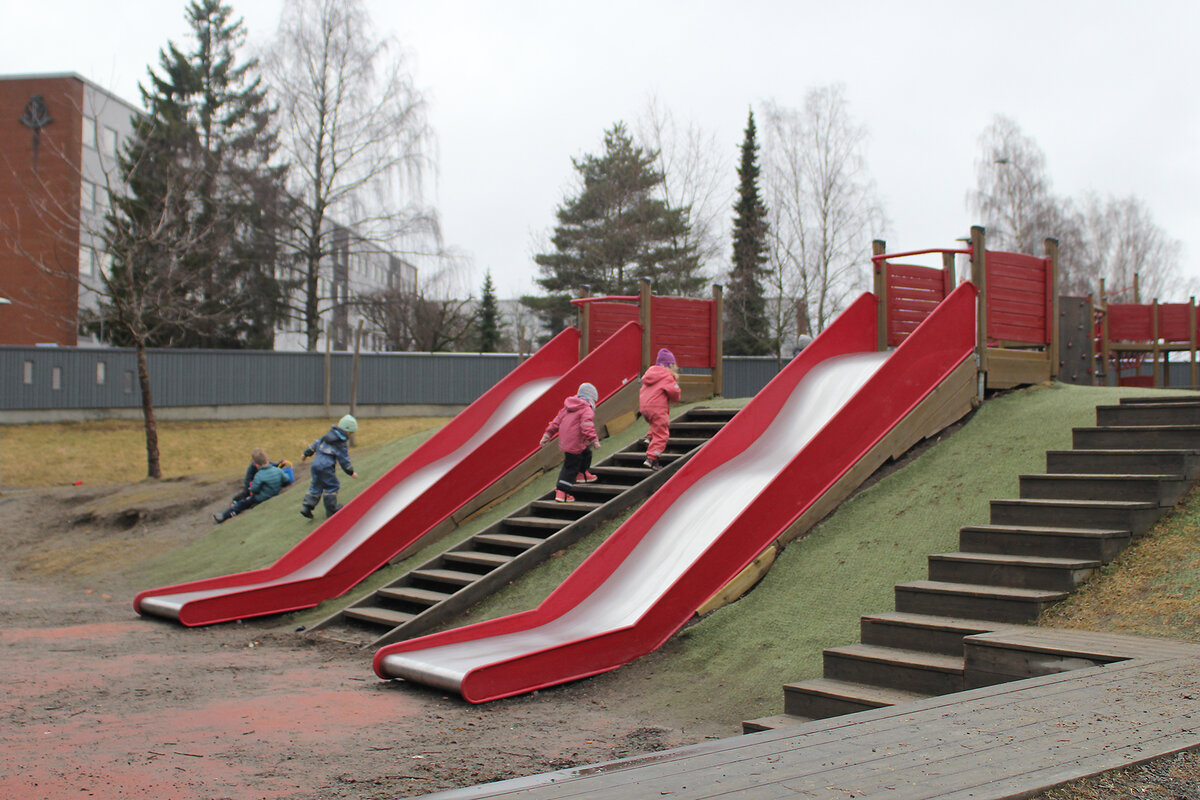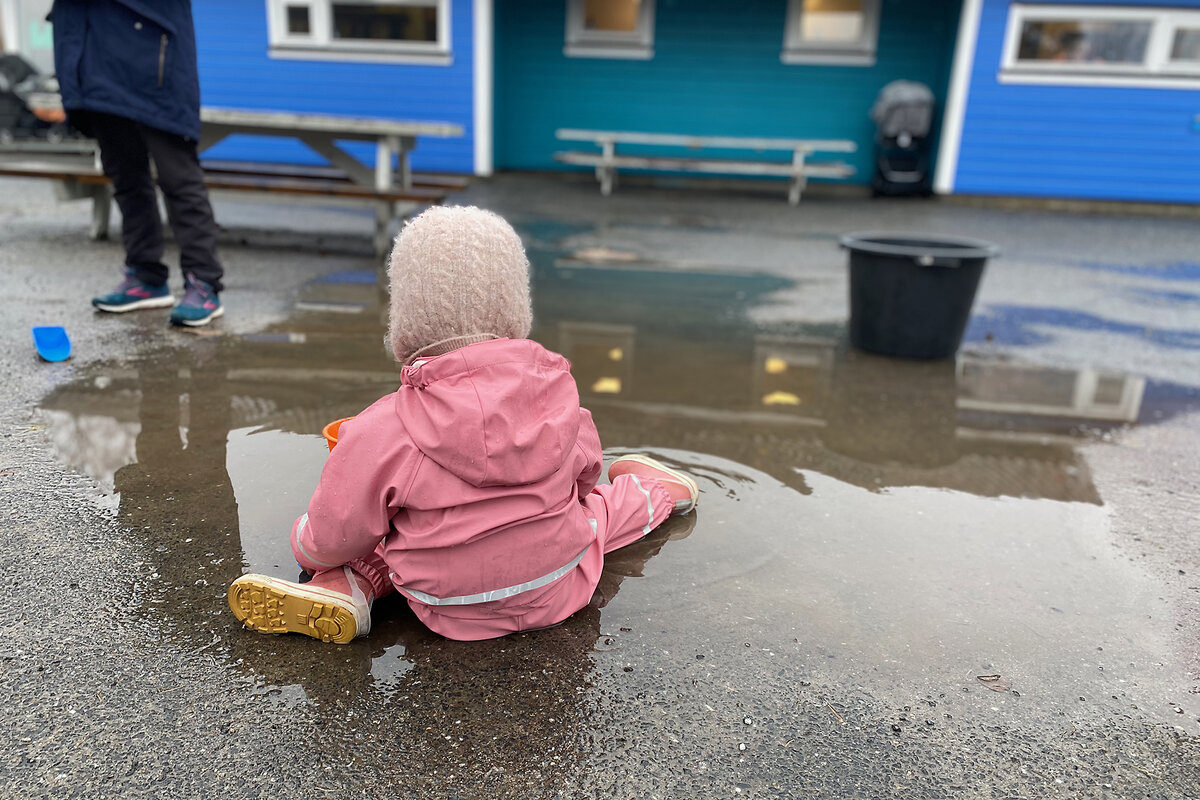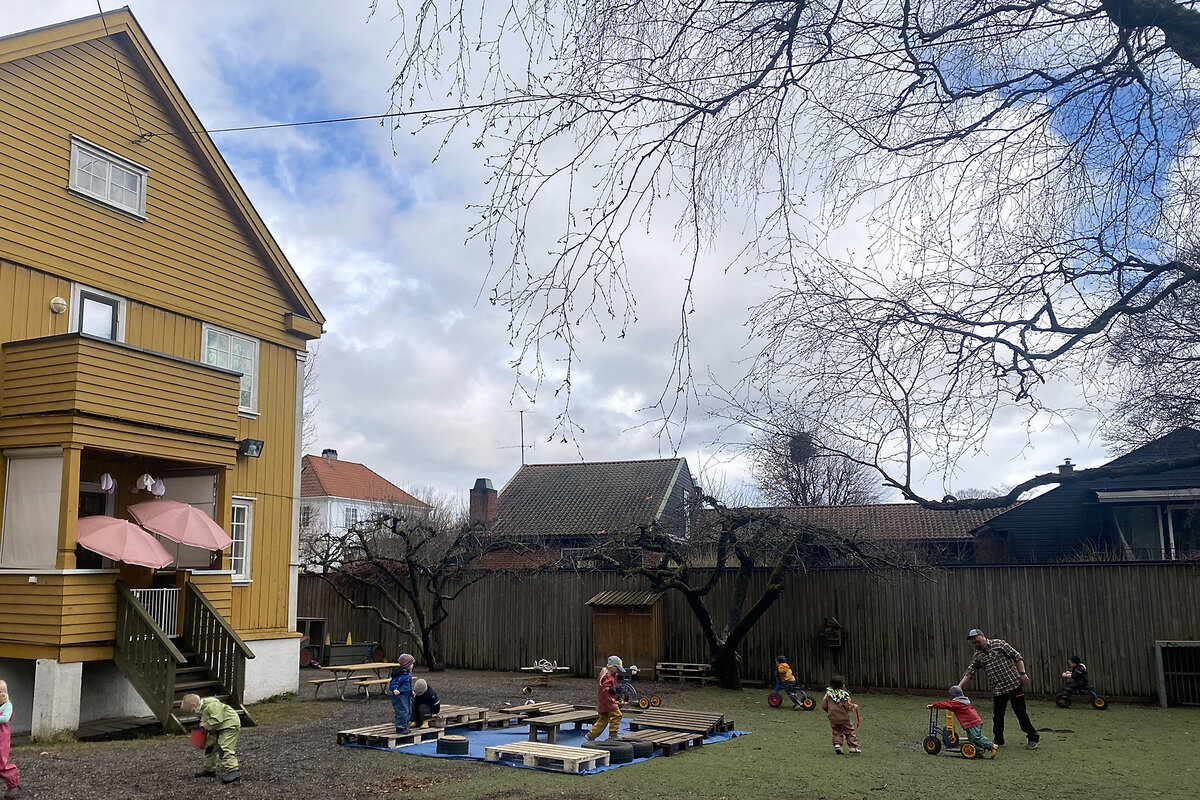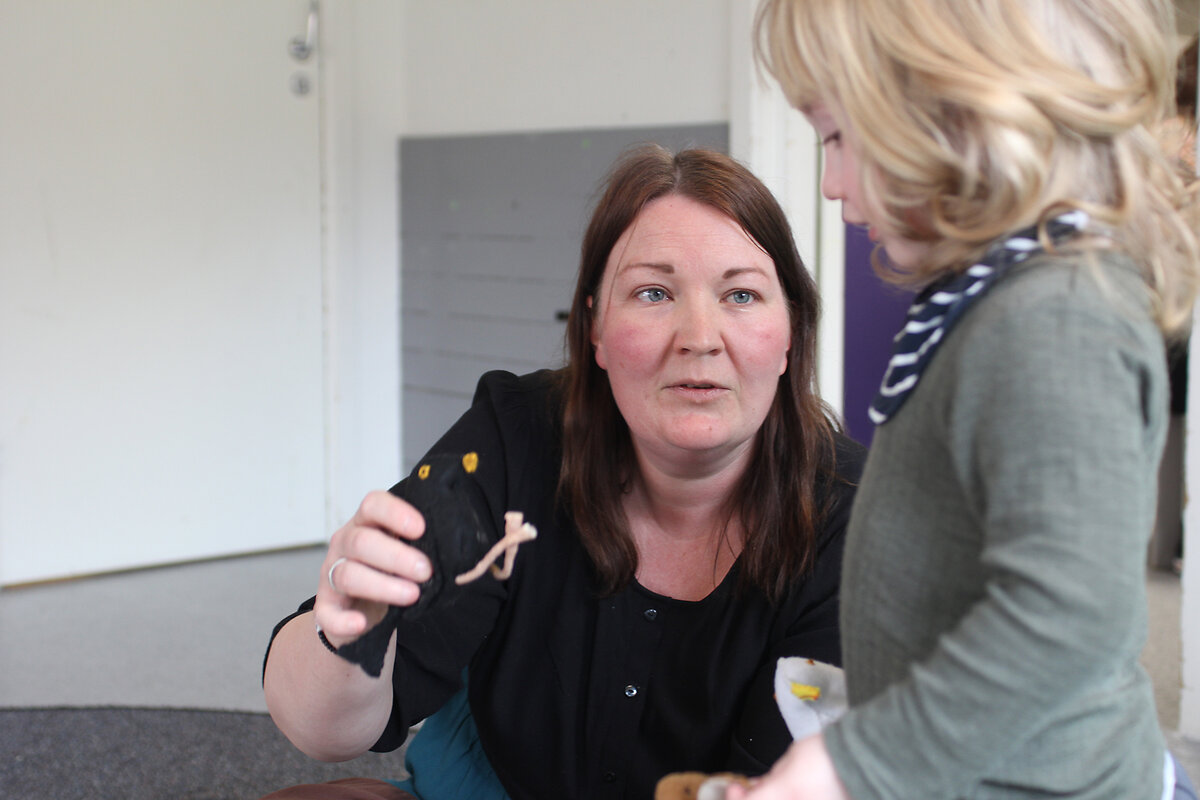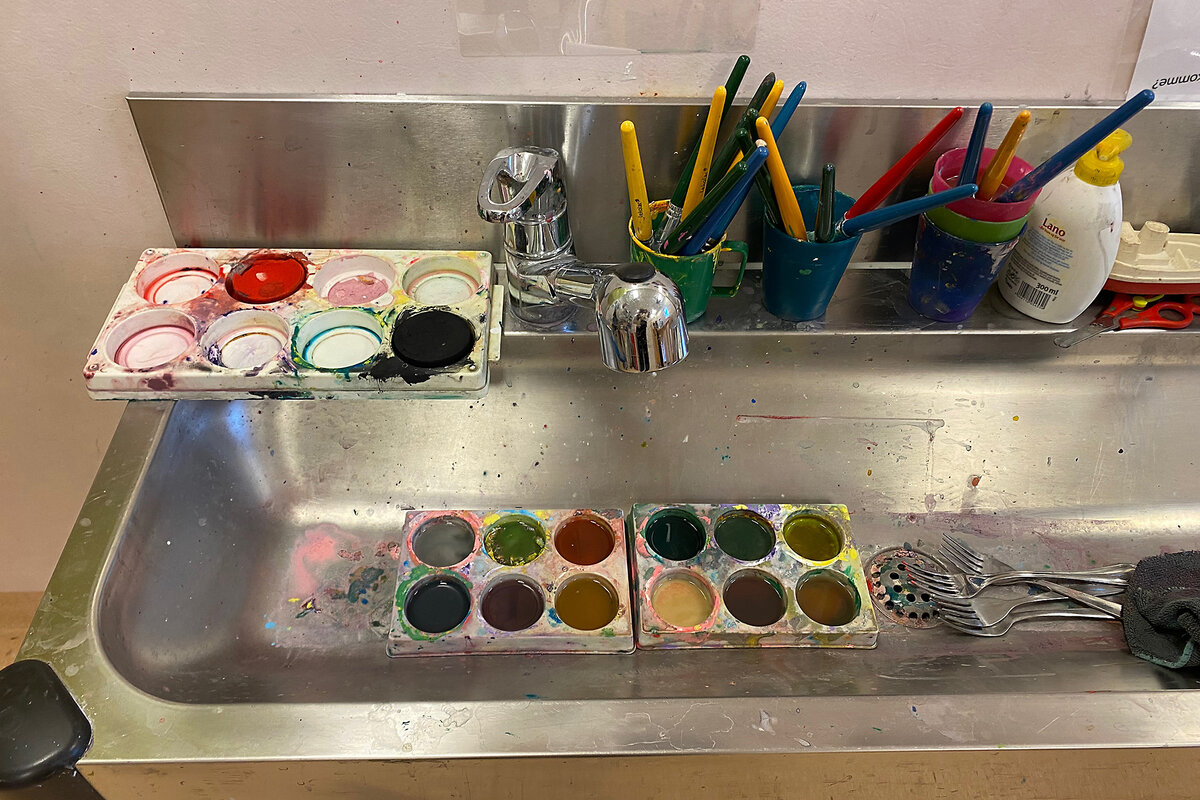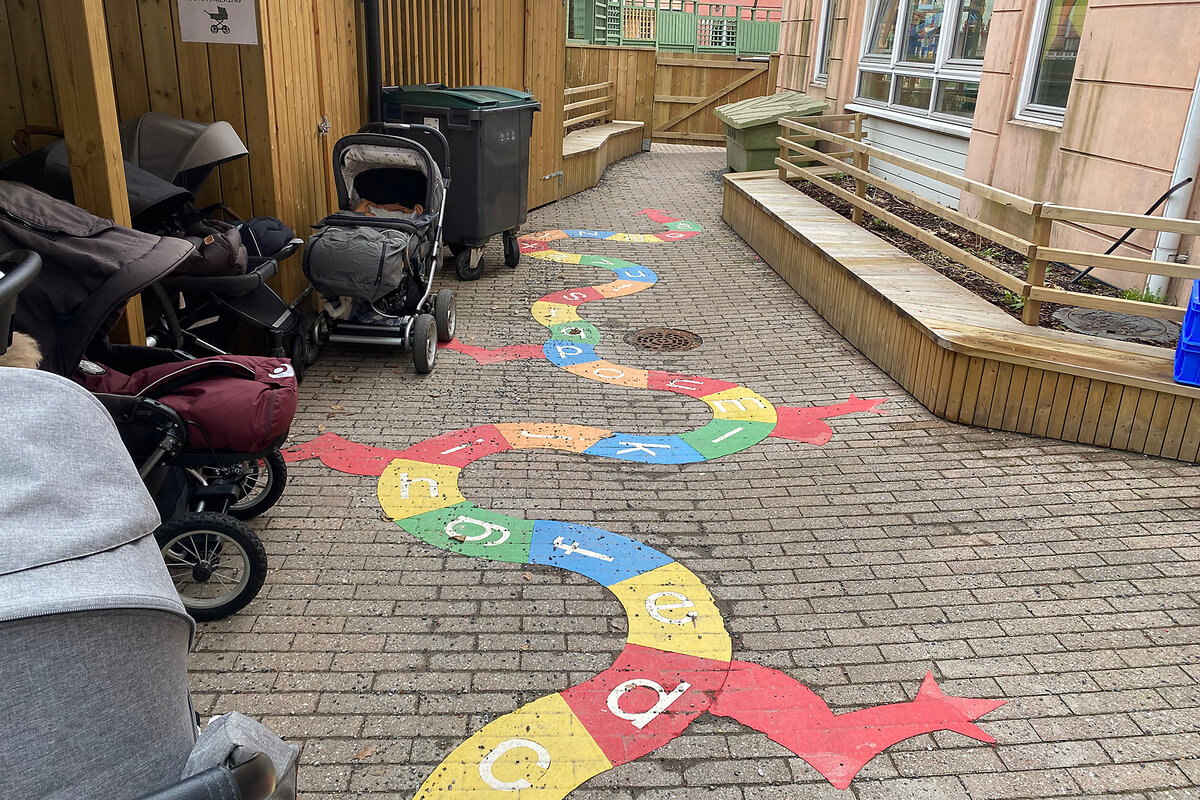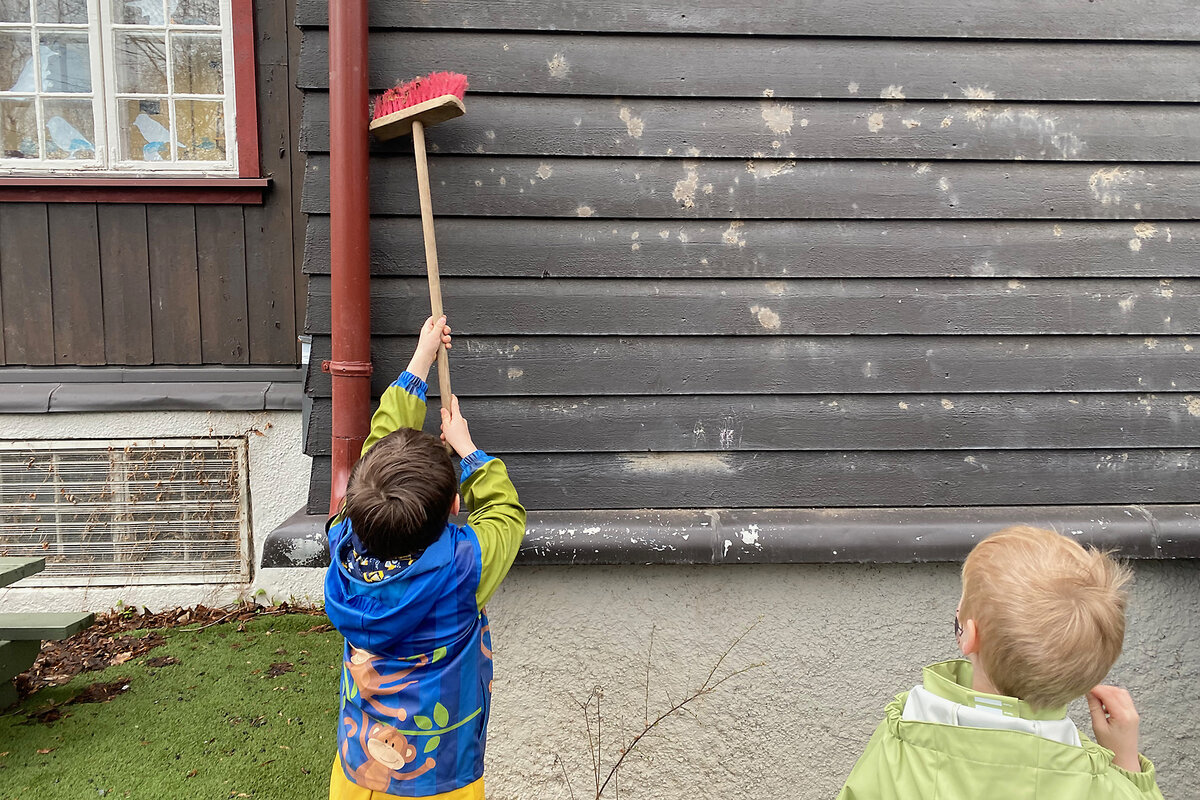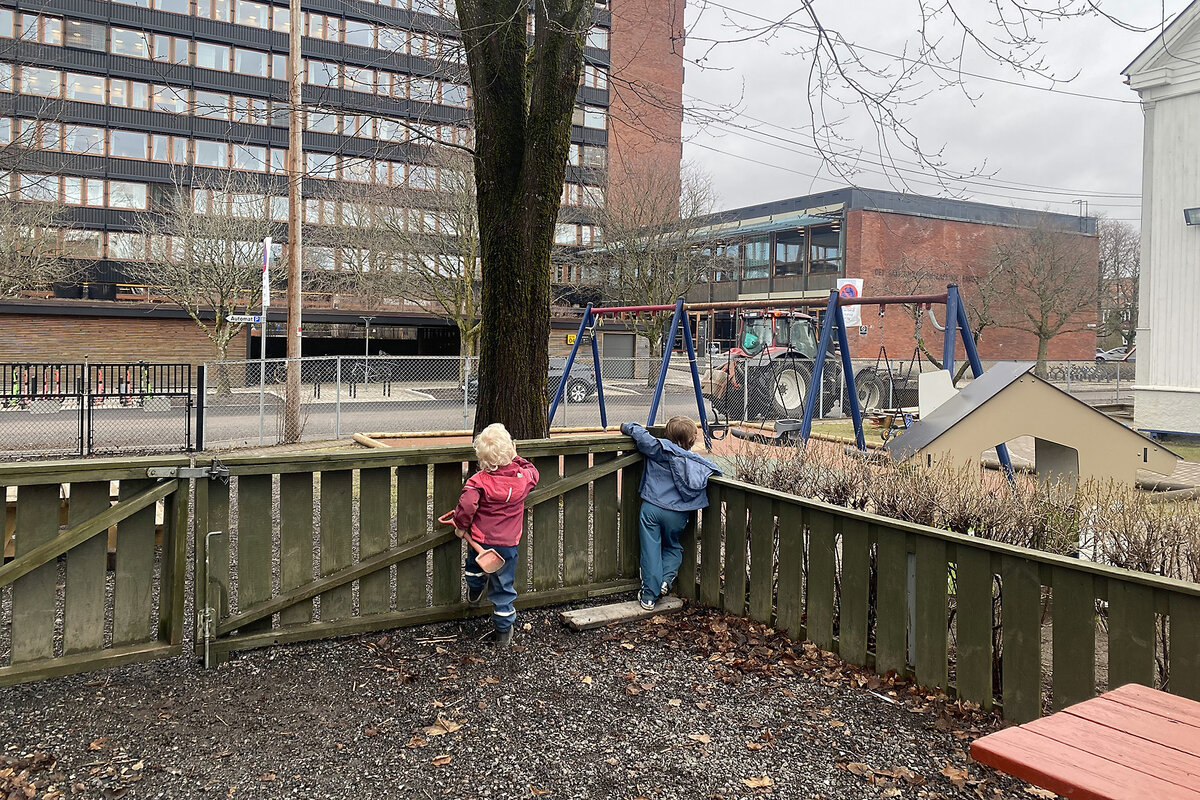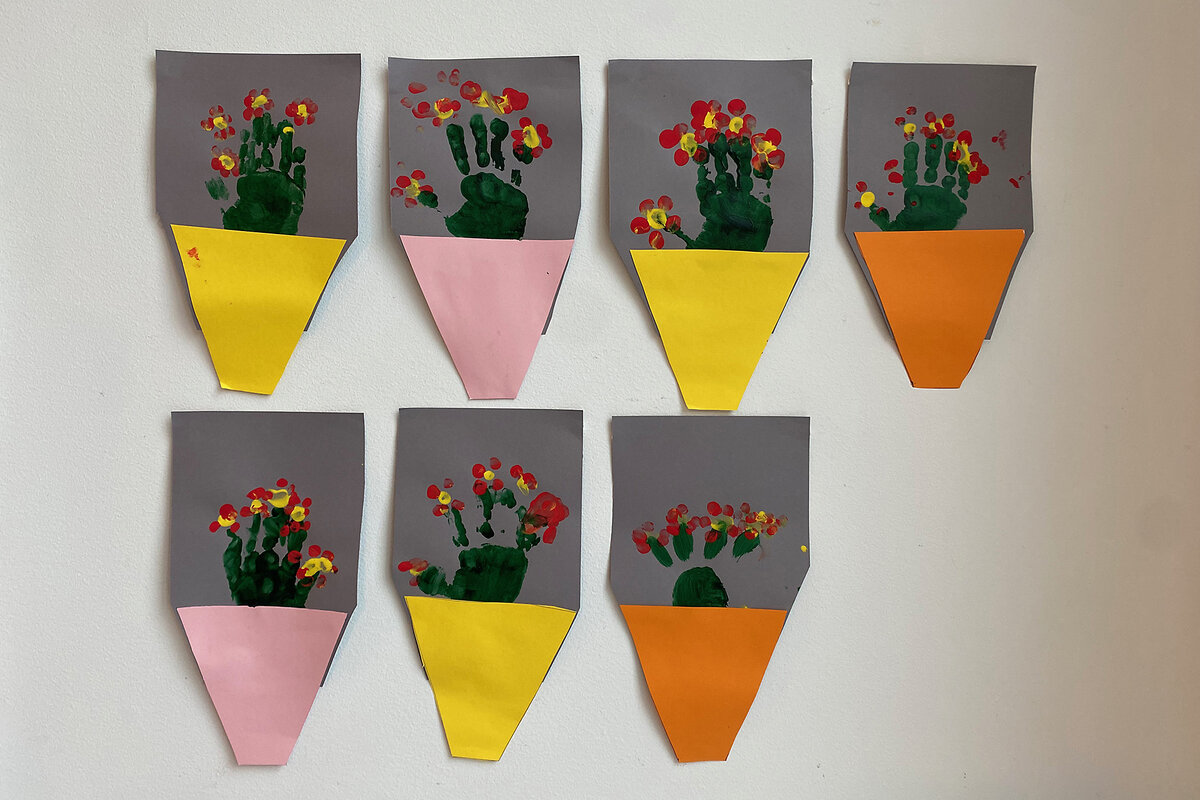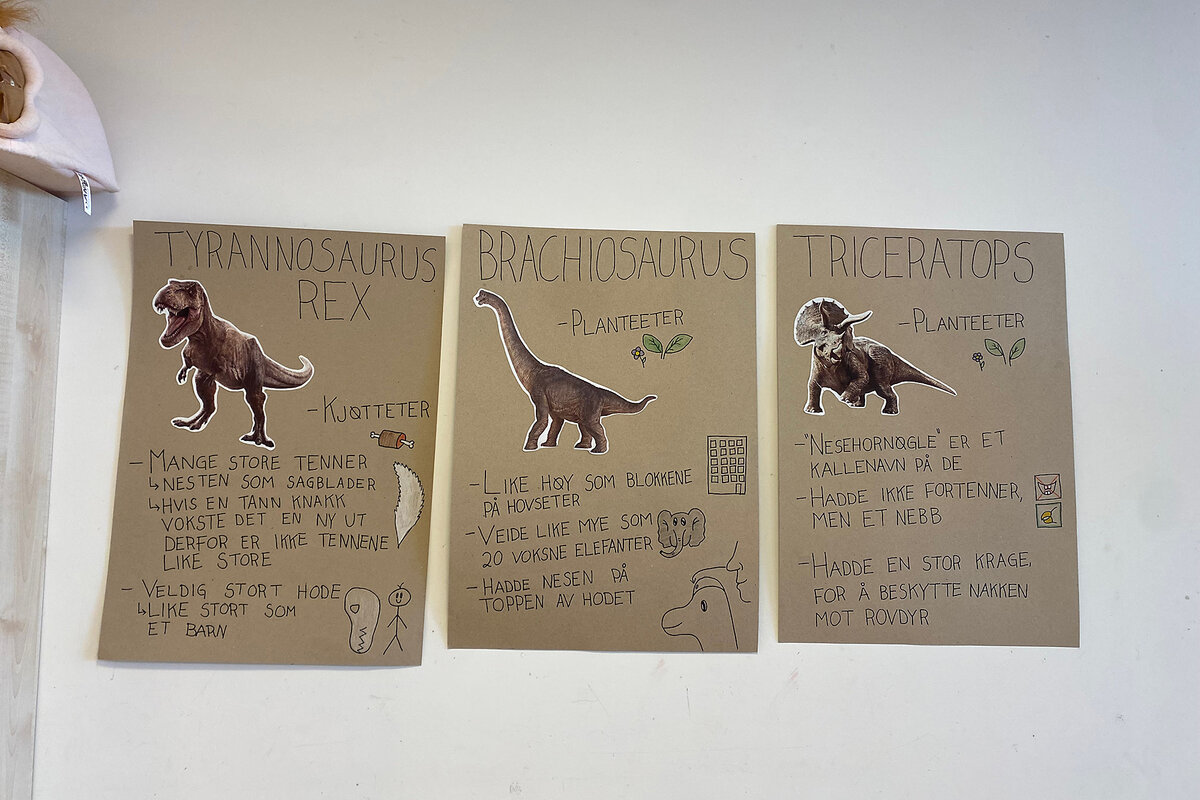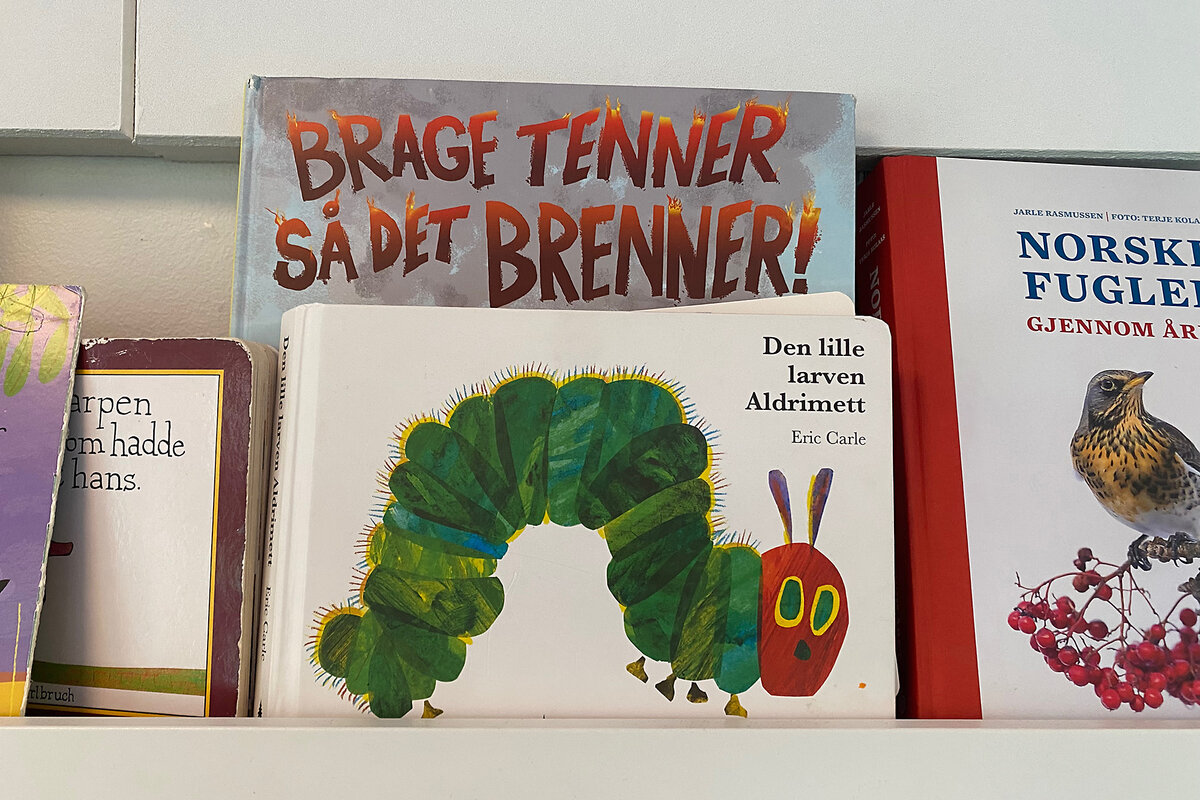In Norway, having a joyful, secure childhood is a right enshrined into law
Loading...
| Oslo, Norway
Just north of Oslo, Sylvia Lorentzen’s two child care programs straddle a narrow, winding road that leads up to the lush forests that encircle parts of Norway’s capital.
In Norway’s system of universal child care, children ages 5 and under immerse themselves in nature. In the winter, those in Ms. Lorentzen’s care learn to ski and sled. In the summer, they swim, canoe, and rock climb – and then rest in hammocks.
Why We Wrote This
A story focused onHow best to raise well-adjusted citizens in a democratic society? In Norway, the process starts early, with an emphasis on childhoods that are joyful, secure, and inclusive.
Around age 4, they learn how to safely use a knife. Then they huddle together outside, whittling wooden figures out of sticks to practice. By age 5, they are cutting logs with a saw and building fires. Toddlers nap outside, bundled inside puffy, miniature sleeping bags affixed to their strollers.
Universal child care is “both seen as an investment for the society and an investment for the child,” says Kristin Aasta Morken, a program leader in the city of Oslo. Public funding covers 85% of operating costs for child care programs in Norway. Parents pay about $182 per month.
In the United States, it’s parents, mostly, who cover the costs for this care – though some employers and local jurisdictions may offer partial reimbursement.
“Kindergarten is so important to level out social inequities,” says Robert Ullmann, head of a consortium of child care centers. “In Norway, we think it’s democratic that everyone can have the same opportunities and move out of being poor. Social differences are something Norway does not accept.”
Robert Ullmann is standing next to one of the floor-to-ceiling windows that shattered 13 years ago when a car bomb exploded a few blocks away.
He’s the head of a consortium of child care centers throughout Norway. Its main office is here on the third floor of a nondescript building on Møllergata street. Just a few blocks away is the Regjeringskvartalet, a cluster of government buildings in central Oslo.
“That’s the prime minister’s office. That’s our ‘Capitol Hill,’” says Mr. Ullmann, pointing out the top of a building just beyond the rusty roof of the building across the road.
Why We Wrote This
A story focused onHow best to raise well-adjusted citizens in a democratic society? In Norway, the process starts early, with an emphasis on childhoods that are joyful, secure, and inclusive.
But it’s now closed. In 2011, a far-right extremist placed a van full of explosives in the government center, causing a blast that killed eight people and wounded more than 200. Hours later, the same assailant opened fire at a youth summer camp 24 miles from central Oslo. He shot and killed 69 people, most of them teenagers and young adults affiliated with the youth wing of the country’s Labour Party.
The force of that blast shattered all the windows in Mr. Ullmann’s office, too. It was summer, so only two employees, one of whom was pregnant, were at their desks at the time. They were not wounded.
The deadly attacks, extraordinarily rare for Norway, affected him deeply, however. Mr. Ullmann, who heads the nonprofit Kanvas and the 64 child care centers it runs, started to reflect about his mission, his organization, and the important role it plays in Norway’s national commitment to the very youngest of its children.
“How can a young guy come up here and become a terrorist?” Mr. Ullmann says, looking out the window as he recalls that day and its existential aftermath. Norway, after all, has long been one of the most crime-free countries in the world.
As the head of an organization devoted to the care and education of children under 5 years old, he has a partial answer: “What’s important is that everyone feel they’re included,” he says.
Indeed, his reflections embody what has long been a primary belief in Norwegian early education: In order to build a nation of thriving adults, you must provide childhoods that are joyful, secure, and inclusive.
“A really important pillar of Norway’s early ed philosophy is the value of childhood in itself,” says Henrik D. Zachrisson, director of the Centre for Research on Equality in Education at the University of Oslo. “Early ed is supposed to be a place where children can be children and have the best childhood possible.”
It’s an idea that undergirds Norway’s nationalized approach to its “kindergartens,” which here serve children age 5 and younger, including toddlers and infants.
In the United States, the idea of child care often connotes a place to leave children so parents can go to work, and mostly at their own expense. Sometimes, these child care centers are called “preschools,” since American kindergarten is understood as a single year for mostly 5- and 6-year-olds.
On a drizzly morning earlier this year at Preståsen Kanvas-barnehage, one of Mr. Ullmann’s kindergarten programs in south Oslo, children roam around an expansive play yard, building sandcastles under the canopy of a large pine tree. Others zoom down a hill on bikes.
In another playground on campus, children shriek as they splash through a large puddle. This draws more children hoping to play. Rather than caution the children about getting wet, a teacher walks over and hands them buckets to have at it.
Children with disabilities, who are often segregated in American child care programs, are included in activities. Some of them have a city-funded aide who attends to their needs.
In some rooms, posters on the wall show pictures of common items or common requests, so children still learning Norwegian can point to what they need. In one room, children are learning about the Muslim holiday, Eid al-Fitr.
At a different Kanvas location, administrators have placed a rack of free clothes and boots in the front lobby, with instructions telling parents to take what they need.
“Kindergarten is so important to level out social inequities,” says Mr. Ullmann. “In Norway, we think it’s democratic that everyone can have the same opportunities and move out of being poor. Social differences are something Norway does not accept.”
Norway’s commitment to universal preschool and child care
In the U.S., child care is largely seen as an individual family’s concern. It is parents, mostly, who cover the costs for this care, though some employers and local jurisdictions may offer partial reimbursement.
In fiscal 2024, the U.S. federal government provided states with over $25 billion in block grants focused on the child care needs of families living in poverty. Nearly 6.3 million American children under age 5 qualify for these funds. Yet only about 840,000 of these children, or about 13%, benefit from these grants, according to an analysis by First Five Years Fund, a Washington-based advocacy group.
In Norway, universal child care is “both seen as an investment for the society and an investment for the child,” says Kristin Aasta Morken, a program leader in the city of Oslo’s focus on upbringing and education.
Ironically, Norway’s policies have been inspired in part by American studies that found troubling language skills gaps between higher- and lower-income children. Other influential American scholarship also revealed high educational returns from investing in early childhood programs.
“The argument I’ve heard is that if you don’t send your children to kindergarten, then you steal some possible experiences from them,” says Adrian Kristinsønn Jacobsen, a doctoral candidate at the University of Stavanger in Norway who studies early childhood science education rooted in experiencing nature.
There are important contexts affecting each country’s approach, however. Norway is home to about 5.5 million people, and about 82% are ethnically Norwegian. This population lives in an area roughly the size of Montana. Norway is also a top producer of oil, which helped generate a per capita household income that was over $104,000 in 2022, according to the International Monetary Fund.
The U.S., on the other hand, has 62 times the number of residents that Norway has and a far more diverse population. In 2022, per capita household income in the U.S. was about $77,000.
In Norway, nearly 1.4% of the country’s gross domestic product goes toward early childhood programs. The U.S. spends less than 0.4% of its GDP, according to the Organization for Economic Cooperation and Development.
Public funding covers 85% of operating costs for child care programs in Norway. As of this summer, the tuition parents pay has been capped at about $182 per month. This applies to both public and private programs, and includes in-home kindergartens, which preserve a certain amount of choice for parents. Programs receive funding on a per-child basis. Kindergartens that care for children under 3 years old receive twice the funding of those ages 3 to 5, since toddlers and infants require more individualized care.
Norwegian children are guaranteed a spot in a kindergarten after they turn 1 year old – about the time many parents’ paid leave ends. If parents decide not to send their children to a kindergarten, they receive financial assistance to stay home.
Norway’s understanding of kindergarten is deeply ingrained in its culture. But these benefits, signed into law in the Kindergarten Act of 2006 – which repeats the word “play” 56 times – also express some of the country’s deeply held values.
Child care programs must acknowledge “the intrinsic value” of childhood, according to the 63-page law. “The Kindergarten must be based on fundamental values in the Christian and humanist heritage and tradition, such as respect for human dignity and nature, on intellectual freedom, charity, forgiveness, equality and solidarity, values that also appear in different religions and beliefs and are rooted in human rights,” the law declares.
The law goes on to insist that kindergarten programs “must be a challenging and safe place for community life and friendship,” allowing children to develop their “creative zest, sense of wonder and need to investigate.”
The law proclaims, too, that kindergartens should “promote democracy and equality and counteract all forms of discrimination.”
What can the U.S. learn from Norway’s approach to child care?
About 7 miles north of Oslo, Sylvia Lorentzen’s two child care programs straddle a narrow, winding road that leads up to the lush forests that encircle parts of Norway’s capital.
Such a setting offers limitless opportunities for children to immerse themselves in nature. In the winter, those in Ms. Lorentzen’s care learn to ski and sled. In the summer, they swim, canoe, and rock climb – and then rest in hammocks.
Around age 4, they learn how to safely use a knife. Then they huddle together outside, whittling wooden figures out of sticks to practice. By age 5, they are cutting logs with a saw and building fires.
It’s 11 a.m. on a Tuesday this past spring at Ms. Lorentzen’s kindergarten, Turi Sletners Barnehave. It’s 39 degrees Fahrenheit outside, but toddlers, who have yet to set foot inside, are bundled up in colorful snowsuits and boots, crunching through the wet snow blanketing their picturesque play yard.
The toddlers splash through muddy puddles and giggle as they chase Ms. Lorentzen’s petite, playful dog.
As the morning wears on, the five toddlers make their way up a gentle slope and step inside a large tent modeled after one commonly used by the Indigenous Sami people of northern Europe. There, the children crowd around a metal firepit and peer at the remnants of their last bonfire.
“What did you find?” asks their teacher, Paula García Tadeo, as a child holds up some charcoal remnants. Ms. García looks closely and nods before instructing the child to put them back.
Another child reaches into the remnants and starts to taste an ashy piece of wood. “Don’t eat it,” she says calmly.
For Ms. Lorentzen and many other early educators here, this sort of laid-back morning, marked by child-led outdoor exploration, is exactly how both child care and early childhood should look.
For Norwegians, experiencing nature and playing outdoors is not just a national tradition; it’s a staple of living.
There’s a name for it here: friluftsliv, which translates to “outdoor life.”
There’s never a wrong time for friluftsliv. In fact, Norwegians have a saying: “There is no bad weather, just bad clothes.”
It’s standard for Norwegian kindergartens to have rows of cubbies just inside the door, each storing layers of spare clothes, including rain and snow gear and boots and mittens.
Indeed, Norwegian children in publicly supported kindergartens spend, on average, 70% of their days outside. This includes the fact that in winter, kids only spend about a third of their time in the midst of friluftsliv.
The country’s embrace of nature, experts believe, is one factor in Norway’s continuing high ranking in international studies of happiness, many of which find that spending time in nature can decrease anxiety and improve cognition.
Here at Ms. Lorentzen’s Turi Sletners, toddlers nap outside, bundled inside puffy, miniature sleeping bags affixed to their strollers.
“Putting all the pieces together, it’s a pretty consistent set of evidence that there are fairly long-term effects” of Norway’s early childhood programs, says Dr. Zachrisson at the University of Oslo.
“Which is funny, because what they do the first year is [walk] around in the woods, eating sand and hugging trees,” he says. “And [it’s] super interesting to try to think of what causes them to do much better on the math test in fifth grade.”
What does Norway’s focus on outdoor play mean for safety?
But what about the risks? On an April afternoon this year, children of professors and researchers at the University of Oslo are roaming around in the expansive play yard of Blindern Barnestuer, a kindergarten just across the street from the university.
In one area, a group of small children crowds around a teacher sitting on a bench as he paints insects on some of their faces at their request. Other kids chase each other up hills as a nearby pirate flag waves overhead. A group of preschoolers balances on an obstacle course constructed of wooden pallets and boards, and they clutch each other’s coats for stability. In another area, 4- and 5-year-olds are climbing trees and dangling from branches.
It looks dangerous – as did the fire and wood-carving knives at other kindergartens. As did the preschoolers chasing each other with brooms or standing on swings. Even now, as kids jump down several feet from tree limbs.
Anne Gro Stumberg, one of the kindergarten’s top teachers, called “pedagogical leaders” in Norway, is unperturbed.
“We allow them to experience, and if they fall down, so what?” Ms. Stumberg says. “I can’t remember having one injury – not a serious injury.”
At Blindern, teachers purposefully avoid teaching formal academics, such as letters and numbers, unless a child is expressly interested in it.
“We think that’s what they’re going to learn in school,” says Ms. Stumberg. “I don’t think it’s necessary to try to learn [reading] before school. There are so many other things that are very important, like all of the social skills, and how to move and do things on your own, and to be able to have your own limits.”
Norway refers to kindergarten staff members as “role models,” and its kindergarten law is exacting when it comes to teacher qualifications and student-teacher ratios.
Programs are required to have one pedagogical leader for every seven children under the age of 3, and one for every 14 children older than that. That leader must be supported by two other teachers. In total, there should a 3-1 ratio of children to staff members for those under age 3, and a 6-1 ratio for those older.
At Jarbakken barnehage, a kindergarten in northwest Oslo, director Mailinn Daljord says qualified teachers are vital.
They must be able to help children through the most critical of lessons: teaching them emotional regulation.
“I want [children] to like being in kindergarten,” she says. “But I also want them to feel disappointment, sadness, and disagreement with others, because here we have grown-ups that will help them with their emotions, so they will learn to handle those situations on their own when they get older.”
One thing Ms. Daljord, like Mr. Ullmann, does not want children to experience is bullying or exclusion. This year, she is especially focused on interactions and inclusion. Her teachers gather small groups of children during play to provide support with their interactions and give children ample opportunity to form connections with peers.
At certain times during the year, Ms. Daljord’s teachers meet to evaluate how much they themselves interact with individual children. Then they zero in on those getting less attention. Often, these are the most challenging.
“You need to do something to make sure all the kids are getting the same, and that they are seen and acknowledged for the person they are,” Ms. Daljord says.
Nearly a decade ago, while visiting a park in the U.S. with her then-nearly 3-year-old daughter, she was approached by an American parent who chastised her for sitting on a bench while her daughter ran free. The woman told Ms. Daljord that she “needed to watch her, and stay close.”
It was to her an amusing clash of contrasting cultural sensibilities.
Why Norway pays parents to stay home with their kids
Norway’s early childhood policies have set it apart. On a host of measures by a host of scholars, the country ranks at or near the top of countries that support the well-being and flourishing of children.
Yet aspects of Norway’s kindergarten system are still being developed, experts say, and many believe the country must adapt as its population becomes more diverse.
Between 2003 and 2018, the percentage of children from ages 1 to 5 attending kindergarten increased from 69% to 91%. Today, Norway is trying to focus more attention on those young children who are behind in language development.
“We’ve known for some time that the quality varies,” says Veslemøy Rydland, professor at the University of Oslo and one of the lead researchers for the Oslo Early Education Study. Despite government requirements, staffing lower-income kindergartens, where turnover rates are higher, can be difficult.
Over the past decade, the number of children with parents who speak a non-Scandinavian language other than English has nearly doubled. Almost 20% of children in Norway’s kindergartens primarily speak a language other than Norwegian. In some cities, as much as 35% of children are minority-language speakers. During the past decade, too, child poverty rates have begun to rise.
Not all of Norway’s early childhood researchers are convinced that the country’s informal approach to early learning will work as its demographics evolve.
“This pedagogy has been doing a great job in protecting childhoods ... and giving children the opportunity to explore,” says Dr. Rydland. But when children have that much freedom, she says, they may not be exposed to activities that could be beneficial, like whole-group reading, if they aren’t interested in it.
Some newcomers are also skeptical of the Norwegian model. Parents who have immigrated to Norway sometimes struggle to accept the freewheeling Norwegian approach to child care, expecting more academics or structure, even for their youngest.
Many immigrants also choose not to enroll their children in kindergarten at all, preferring Norway’s generous but divisive social policy that pays parents who stay home to care for their children – which is sometimes called “cash for care.”
Norwegian educators say this is unfortunate, since children new to Norway are the ones who could benefit the most from its child care system and from more exposure to the Norwegian language.
Norway’s aim: A universal child care system rooted in trust
Elise Kristin Hagen Steffensen, director of Barnebo Barnehage in north Oslo, describes Norwegian kindergartens as a system based on trust.
Programs report issues, as small as forgetting to lock a window or as big as teacher mistreatment of children. Ms. Hagen Steffensen regularly writes reports for the city, explaining how the organization is meeting various parts of the law’s requirements.
Officials may visit, especially if a kindergarten is struggling. The government tracks staffing numbers and parent satisfaction metrics. But there are no fines when troubles arise or a program struggles to conform to the law’s strict regulations. Instead, local kindergarten officials strive to help programs improve.
It’s a sense of trust that seems to pervade Norwegian society. Fences are few and far between in Norway. The country’s “right to roam” law allows individuals to freely and responsibly enjoy “uncultivated” areas, regardless of who owns them.
Looking forward, Norway’s early educators and experts aren’t quite ready to declare full success in building their system, especially as the country’s demographics slowly begin to change. Many still would like to fine-tune existing standards to better ensure the high quality of kindergartens, including even lower student-to-teacher ratios – which are already very low compared with ratios in the U.S.
Mr. Ullmann at Kanvas, too, thinks there is still room to improve Norway’s fierce commitment to early childhood education and care.
“If you take the money and the structural quality that we offer in Norway, yeah, compared to every other country in the world, these are more or less the most expensive kindergartens in the world,” Mr. Ullmann says. “It’s fantastic when you compare it to every other country.”
But, he adds, even that may not be enough when it comes to the youngest of children, on whom the future rests.
This story was produced by The Hechinger Report, a nonprofit, independent news organization focused on inequality and innovation in education, with support from the Spencer Fellowship at Columbia Journalism School. Sign up for the Hechinger newsletter.





